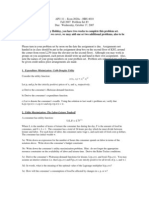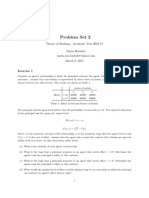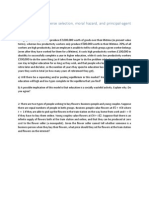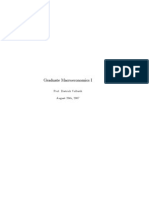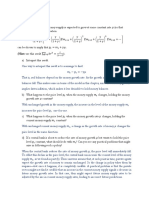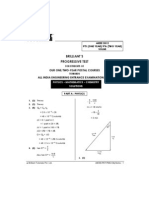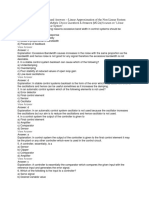Chiang/Wainwright: Fundamental Methods of Mathematical Economics Instructor S Manual
Uploaded by
bonadieChiang/Wainwright: Fundamental Methods of Mathematical Economics Instructor S Manual
Uploaded by
bonadieChiang/Wainwright: Fundamental Methods of Mathematical Economics
Instructor;s Manual
CHAPTER 4
Exercise 4.1
1.
Coe
Qd
Qs
Qd
+bP
Qs
dP
cient M atrix:
Vector of Constants:
=0
=a
2.
Qd1
Qs1
=0
Qd1
Qs1
Qd2
a1 P1
a2 P2
= a0
b1 P1
b2 P2
= b0
Qs2
=0
Qd2
Qs2
Coe
cient m atrix:
1 P1
2 P2
1 P1
2 P2
Variable vector:
Constant vector:
1 0
Qd1
0 0
a1
a2
Qs1
a0
1 0
b1
b2
Qd2
b0
0 1
Qs2
0 1
P1
0 0
P2
3. No, because the equation system is nonlinear
4.
Y
bY + C
= I0 + G0
= a
The coe cient matrix and constant vector are
1
I0 + G0
13
Chiang/Wainwright: Fundamental Methods of Mathematical Economics
5. First expand the multiplicative expression (b(Y
that bY and
Instructor;s Manual
T ) into the additive expression bY
bT can be placed in separate columns. Then we can write the system as
Y
bY
+bT
tY
+T
+C
= I0 + G0
=a
=d
Exercise 4.2
1.
(a)
7 3
(b)
9 7
(c)
21
18
27
(d)
16
22
24
2.
28 64
(a) Yes AB =
. No, not conformable.
13 8
(b) Both are dened, but BC =
14
6= CB =
69 30
1
5
3. Yes. BA =
3+
2
5
12
10
1
5
0
28
10
3
5
2+
6
10
3
5
20 16
21 24
1 0 0
14
10
0 1 0
6
2
0 0 1
0
5
10
Thus we happen to have AB = BA in this particular case.
0
4.
(a)
36 20
16
4
10
(b)
49 3
4 3
3x + 5y
(c)
4x + 2y
(22)
(d)
7z
(21)
(32)
5. Yes. Yes.
Yes. Yes.
6.
(a) x2 + x3 + x4 + x5
(b) a5 + a6 x6 + a7 x7 + a8 x8
(c) b(x1 + x2 + x3 + x4 )
(d) a1 x0 + a2 x1 + + an xn
= a1 + a2 x + a3 x2 + + an xn
14
7a + c 2b + 4c
(12)
bT so
Chiang/Wainwright: Fundamental Methods of Mathematical Economics
Instructor;s Manual
(e) x2 + (x + 1)2 + (x + 2)2 + (x + 3)2
7.
(a)
3
P
ixi (xi
1)
(b)
i=1
8.
(a)
(b)
n
P
4
P
ai (xi+1 + i)
(c)
i=2
xi
i=1
n
P
i=1
1
xi
+ xn+1 = x0 + x1 + + xn + xn+1 =
n
X
abj yj
(d)
n
P
i=0
n+1
P
1
xi
xi
i=1
= ab1 y1 + ab2 y2 + + abn yn
j=1
= a(b1 y1 + b2 y2 + + bn yn ) = a
n
X
bj yj
j=1
(c)
n
X
(xj + yj ) = (x1 + y1 ) + (x2 + y2 ) + + (xn + yn )
j=1
= (x1 + x2 + + xn ) + (y1 + y2 + + yn )
n
n
X
X
=
xj +
yj
j=1
j=1
Exercise 4.3
1.
5
0
(a) uv =
1
3
5
(b) uw0 =
1
3
x1
(c) xx =
x2
x3
(d) v u =
3 1
3 1
h
h
5 7 8
x1
x2
x3
15 5
35 25 40
=
21 15 24
x21
x1 x2
x1 x3
x2 x1
x22
x2 x3
x3 x1
x3 x2
x23
5
1
= [15 + 1
3] = [44] = 44
3
15
Chiang/Wainwright: Fundamental Methods of Mathematical Economics
(e) u v =
(f) w x =
(g) u0 u =
(h) x x =
h
h
h
h
7 5 8
5 1 3
x1
5 1 3
x2
x3
Instructor;s Manual
= [15 + 1
3] = 13
1
x1
= [7x1 + 5x2 + 8x3 ] = 7x1 + 5x2 + 8x3
x2
x3
5
= [25 + 1 + 9] = [35] = 35
1
3
x1
P
= x21 + x22 + x23 =
x2i
x2
i=1
x3
2.
(a) All are dened except w0 x and x0 y 0 .
x1
(b) xy 0 =
xy 0 =
x2
h
zz 0 =
yw0 =
y1
y2
z1
z2
y1
y1
y2
y1
z1
z2
x1 y2
x2 y1
x2 y2
= y12 + y22
y2
i
3 2 16
y2
x y = x1 y1 + x2 y2
x1 y1
z12
z1 z2
z2 z1
z22
3y1
2y1
16y1
3y2
2y2
16y2
3.
(a)
n
P
Pi Qi
i=1
(b) Let P and Q be the column vectors or prices and quantities, respectively. Then the total
revenue is P Q or P 0 Q or Q0 P .
16
Chiang/Wainwright: Fundamental Methods of Mathematical Economics
Instructor;s Manual
4.
(a) w10 w2 = 11 (acute angle, Fig. 4.2c)
(b) w10 w2 =
11 (obtuse angle, Fig. 4.2d)
(c) w10 w2 =
13 (obtuse angle, Fig. 4.2b)
(d) w10 w2 = 0 (right angle, Fig. 4.3)
(e) w10 w2 = 5 (acute angle, Fig. 4.3)
5.
(a) 2v =
(b) u + v =
6
(d) v u =
(c) u
v=
4
5
(e) 2u + 3v =
(a) 4e1 + 7e2
(b) 25e1
(c)
(d) 2e1 + 8e3
e1 + 6e2 + 9e3
5
2
10
(f) 4u
2v =
20
2
11
2
6.
2e2 + e3
7.
p
(3
p
(b) d = (9
(a) d =
0)2 + (2 + 1)2 + (8
2)2 + 0 + (4 + 4)2 =
5)2 =
27
113
8. When u, v, and w all lie on a single straight line.
9. Let the vector v have the elements (a1 , . . . , an ). The point of origin has the elements (0, . . . , 0).
Hence:
(a)
d(0, v) = d(v, 0)
(b) d(v, 0) = (v 0 v)1/2
p
(a1 0)2 + . . . + (an
p
= a21 + . . . + a2n
=
0)2
[See Example 3 in this section]
(c) d(v, 0) = (v v)1/2
Exercise 4.4
1.
(a) (A + B) + C = A + (B + C) =
17
11 17
17
You might also like
- Full Download Intermediate Macroeconomics Robert J Barro PDF100% (2)Full Download Intermediate Macroeconomics Robert J Barro PDF64 pages
- Business and Economic Forecasting EMET3007/EMET8012 Problem Set 1No ratings yetBusiness and Economic Forecasting EMET3007/EMET8012 Problem Set 12 pages
- The Barro-Gordon Model: 1 The Idea of Time InconsistencyNo ratings yetThe Barro-Gordon Model: 1 The Idea of Time Inconsistency9 pages
- Midterm Exam - Econ 4020 v1 19 March 2018 Department of Economics York UniversityNo ratings yetMidterm Exam - Econ 4020 v1 19 March 2018 Department of Economics York University12 pages
- Problem Set 2: Theory of Banking - Academic Year 2016-17No ratings yetProblem Set 2: Theory of Banking - Academic Year 2016-175 pages
- Linear Models and Matrix Algebra: Alpha Chiang, Fundamental Methods of Mathematical Economics 3 EditionNo ratings yetLinear Models and Matrix Algebra: Alpha Chiang, Fundamental Methods of Mathematical Economics 3 Edition32 pages
- Microeconomie Livre Micro de Jehly SolutionnaireNo ratings yetMicroeconomie Livre Micro de Jehly Solutionnaire33 pages
- π=R R C Q Q Q Q: Practice problems on Module 3 (Markets) / Solutions to Questions 1 and 4No ratings yetπ=R R C Q Q Q Q: Practice problems on Module 3 (Markets) / Solutions to Questions 1 and 42 pages
- Problem Set For Chapter 11: Foundations of Modern MacroeconomicsNo ratings yetProblem Set For Chapter 11: Foundations of Modern Macroeconomics8 pages
- Solutions To Problem Set 1: Theory of Banking - Academic Year 2016-17 Maria Bachelet February 24, 2017No ratings yetSolutions To Problem Set 1: Theory of Banking - Academic Year 2016-17 Maria Bachelet February 24, 20176 pages
- Exercises Chapter 4. The Phillips Curve. With SolutionsNo ratings yetExercises Chapter 4. The Phillips Curve. With Solutions8 pages
- This Paper Is Not To Be Removed From The Examination HallsNo ratings yetThis Paper Is Not To Be Removed From The Examination Halls55 pages
- Qdoc - Tips - Advanced-Microeconomics-Analysis-Worked-Solutions - 3333 PDFNo ratings yetQdoc - Tips - Advanced-Microeconomics-Analysis-Worked-Solutions - 3333 PDF7 pages
- R R D DE R E DE R R R D DE: Modigliani-Miller TheoremNo ratings yetR R D DE R E DE R R R D DE: Modigliani-Miller Theorem13 pages
- 2013 Vcaa Specialist Mathematics Exam 2 SolutionsNo ratings yet2013 Vcaa Specialist Mathematics Exam 2 Solutions4 pages
- Brilliant'S Progressive Test: Our One/Two-Year Postal Courses All India Engineering Entrance Examination, 2012No ratings yetBrilliant'S Progressive Test: Our One/Two-Year Postal Courses All India Engineering Entrance Examination, 201211 pages
- 111 112 103 104 110 102 U V W EGR Valve MotorNo ratings yet111 112 103 104 110 102 U V W EGR Valve Motor1 page
- Immediate download Reservoir Engineering Handbook 2nd Edition Tarek Ahmed Phd Pe ebooks 2024100% (1)Immediate download Reservoir Engineering Handbook 2nd Edition Tarek Ahmed Phd Pe ebooks 202445 pages
- Plate Load Test Din 18134 Ev1ev2 Lab FormNo ratings yetPlate Load Test Din 18134 Ev1ev2 Lab Form1 page
- Problem Set No.1 Water and Wasterwater EngineeringNo ratings yetProblem Set No.1 Water and Wasterwater Engineering3 pages
- Download Complete (Ebook) Introduction to Software Testing by Paul Ammann, Jeff Offutt ISBN 9781107172012, 9781316774366, 1107172012, 1316774368 PDF for All Chapters100% (9)Download Complete (Ebook) Introduction to Software Testing by Paul Ammann, Jeff Offutt ISBN 9781107172012, 9781316774366, 1107172012, 1316774368 PDF for All Chapters55 pages
- Scheme of Studies For BS Civil Engineering Program Effective From Fall-2018No ratings yetScheme of Studies For BS Civil Engineering Program Effective From Fall-20182 pages
- Vectors Tensors 16 Curvilinear CoordinatesNo ratings yetVectors Tensors 16 Curvilinear Coordinates25 pages
- Questions & Answers On Control System and ComponentsNo ratings yetQuestions & Answers On Control System and Components13 pages
- Application of Integrals: Date: ..............No ratings yetApplication of Integrals: Date: ..............8 pages
- A Brief Comparison and Contrast Between Sir Isaac Newton and Albert EinsteinNo ratings yetA Brief Comparison and Contrast Between Sir Isaac Newton and Albert Einstein3 pages
- Y5 Autumn Block 5 Wo3 Area of Rectangles 2019No ratings yetY5 Autumn Block 5 Wo3 Area of Rectangles 20192 pages
- Step-By-Step Solution Guide For Solving The Combustion Calculation ExerciseNo ratings yetStep-By-Step Solution Guide For Solving The Combustion Calculation Exercise6 pages
- Download full Understanding Mass Spectra A Basic Approach Second Edition R. Martin Smith(Auth.) ebook all chapters100% (6)Download full Understanding Mass Spectra A Basic Approach Second Edition R. Martin Smith(Auth.) ebook all chapters60 pages
- Full Download Intermediate Macroeconomics Robert J Barro PDFFull Download Intermediate Macroeconomics Robert J Barro PDF
- Business and Economic Forecasting EMET3007/EMET8012 Problem Set 1Business and Economic Forecasting EMET3007/EMET8012 Problem Set 1
- The Barro-Gordon Model: 1 The Idea of Time InconsistencyThe Barro-Gordon Model: 1 The Idea of Time Inconsistency
- Midterm Exam - Econ 4020 v1 19 March 2018 Department of Economics York UniversityMidterm Exam - Econ 4020 v1 19 March 2018 Department of Economics York University
- Problem Set 2: Theory of Banking - Academic Year 2016-17Problem Set 2: Theory of Banking - Academic Year 2016-17
- Linear Models and Matrix Algebra: Alpha Chiang, Fundamental Methods of Mathematical Economics 3 EditionLinear Models and Matrix Algebra: Alpha Chiang, Fundamental Methods of Mathematical Economics 3 Edition
- π=R R C Q Q Q Q: Practice problems on Module 3 (Markets) / Solutions to Questions 1 and 4π=R R C Q Q Q Q: Practice problems on Module 3 (Markets) / Solutions to Questions 1 and 4
- Problem Set For Chapter 11: Foundations of Modern MacroeconomicsProblem Set For Chapter 11: Foundations of Modern Macroeconomics
- Solutions To Problem Set 1: Theory of Banking - Academic Year 2016-17 Maria Bachelet February 24, 2017Solutions To Problem Set 1: Theory of Banking - Academic Year 2016-17 Maria Bachelet February 24, 2017
- Exercises Chapter 4. The Phillips Curve. With SolutionsExercises Chapter 4. The Phillips Curve. With Solutions
- This Paper Is Not To Be Removed From The Examination HallsThis Paper Is Not To Be Removed From The Examination Halls
- Qdoc - Tips - Advanced-Microeconomics-Analysis-Worked-Solutions - 3333 PDFQdoc - Tips - Advanced-Microeconomics-Analysis-Worked-Solutions - 3333 PDF
- R R D DE R E DE R R R D DE: Modigliani-Miller TheoremR R D DE R E DE R R R D DE: Modigliani-Miller Theorem
- Exam Prep for:: Macro Tb T/A Principles Of EconomicsFrom EverandExam Prep for:: Macro Tb T/A Principles Of Economics
- Brilliant'S Progressive Test: Our One/Two-Year Postal Courses All India Engineering Entrance Examination, 2012Brilliant'S Progressive Test: Our One/Two-Year Postal Courses All India Engineering Entrance Examination, 2012
- Immediate download Reservoir Engineering Handbook 2nd Edition Tarek Ahmed Phd Pe ebooks 2024Immediate download Reservoir Engineering Handbook 2nd Edition Tarek Ahmed Phd Pe ebooks 2024
- Problem Set No.1 Water and Wasterwater EngineeringProblem Set No.1 Water and Wasterwater Engineering
- Download Complete (Ebook) Introduction to Software Testing by Paul Ammann, Jeff Offutt ISBN 9781107172012, 9781316774366, 1107172012, 1316774368 PDF for All ChaptersDownload Complete (Ebook) Introduction to Software Testing by Paul Ammann, Jeff Offutt ISBN 9781107172012, 9781316774366, 1107172012, 1316774368 PDF for All Chapters
- Scheme of Studies For BS Civil Engineering Program Effective From Fall-2018Scheme of Studies For BS Civil Engineering Program Effective From Fall-2018
- Questions & Answers On Control System and ComponentsQuestions & Answers On Control System and Components
- A Brief Comparison and Contrast Between Sir Isaac Newton and Albert EinsteinA Brief Comparison and Contrast Between Sir Isaac Newton and Albert Einstein
- Step-By-Step Solution Guide For Solving The Combustion Calculation ExerciseStep-By-Step Solution Guide For Solving The Combustion Calculation Exercise
- Download full Understanding Mass Spectra A Basic Approach Second Edition R. Martin Smith(Auth.) ebook all chaptersDownload full Understanding Mass Spectra A Basic Approach Second Edition R. Martin Smith(Auth.) ebook all chapters













